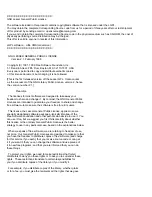
385
Index
Symbols
(RSM) see Removable Storage Manager
A
Access Management 19, 91, 211
accessibility features xxxi
ACS (see Automated Cartridge System)
ACS_ vm.conf entry 320
acsd process 350
acstest 347, 350
adding
cleaning tapes 70
drives 58
robot 46
shared drives 57
volume pool 107
volumes
actions menu 120
update volume configuration 119
ADIC Automated Media Library (AML) 373
ADIC software, installing 375
ADJ_LSM, vm.conf entry 320
administrator quick reference 316
advanced configuration topics 299
advanced options, robot inventory 152, 164
Allow Backups to Span Media 306
Allow Media Overwrite 302
allowable Media Manager characters 34,
103, 227
alternate media types
ACS robots 342
defined 252
example 253
AML (see Distributed AML Server)
AMU (see Archive Management Unit)
API robots 2, 133, 164, 187, 287, 339, 353, 361,
373
API_BARCODE_RULES, vm.conf entry 321
Archive Management Unit (AMU) 374
assigned
host, drive status 221
volumes 140
assigning tape requests 237
ATL (see Automated Tape Library)
authentication/authorization 38, 311
AUTHORIZATION_REQUIRED, vm.conf
entry 322
auto cleaning 275
AUTO_UPDATE_ROBOT, vm.conf
entry 322
Automated Cartridge System
adding volumes 347
barcode operations 348
configuration example 85
drive information 64
Library Server (ACSLS) 339, 341
media requests 342
removing tapes 347
special characters 347
STK Library Station 339, 341
Storagenet 6000 (SN6000) 339, 341, 345
Automated Tape Library (ATL) 364
Automatic Volume Recognition (AVR)
setting 212
AVRD_PEND_DELAY, vm.conf entry 323
AVRD_SCAN_DELAY, vm.conf entry 322
B
Backup Exec
managing volumes 89, 151, 235
barcode rules
add 178
change 179
overview 287
tag 180
barcodes
overview 285
update in robot 151, 206
Summary of Contents for NetBackupTM 5.0
Page 1: ...N102408 VERITAS NetBackup 5 0 Media Manager System Administrator s Guide for Windows ...
Page 4: ...iv NetBackup Media Manager System Administrator s Guide for Windows ...
Page 24: ...xxiv NetBackup Media Manager System Administrator s Guide for Windows ...
Page 34: ...Conventions xxxiv NetBackup Media Manager System Administrator s Guide for Windows ...
Page 50: ...Security Issues 16 NetBackup Media Manager System Administrator s Guide for Windows ...
Page 184: ...Recycling Volumes 150 NetBackup Media Manager System Administrator s Guide for Windows ...
Page 276: ...Denying Requests 242 NetBackup Media Manager System Administrator s Guide for Windows ...
Page 428: ...394 NetBackup Media Manager System Administrator s Guide for Windows ...










































